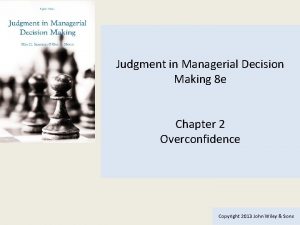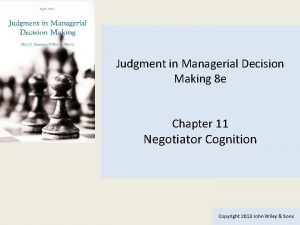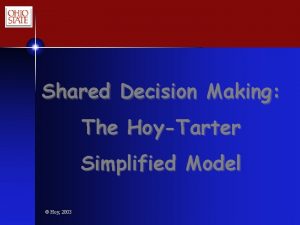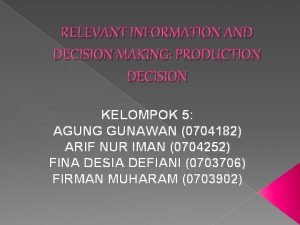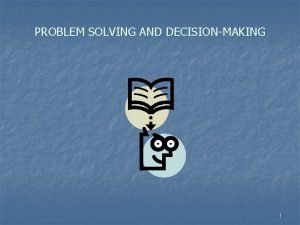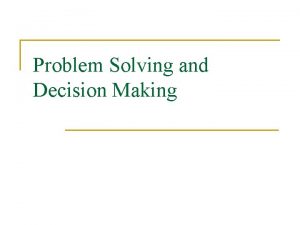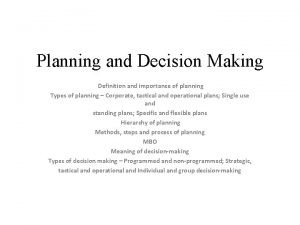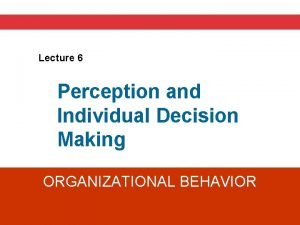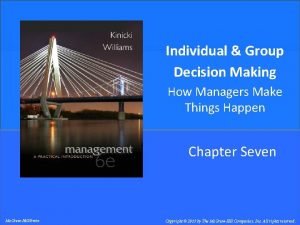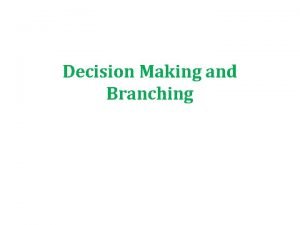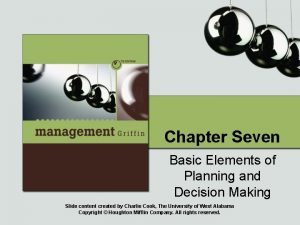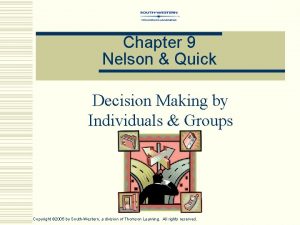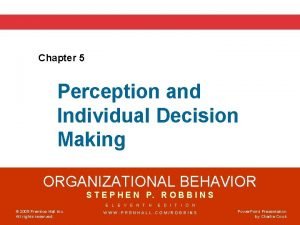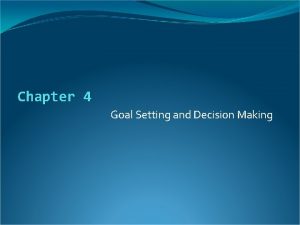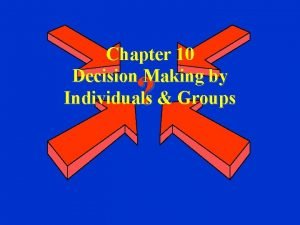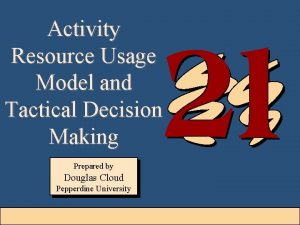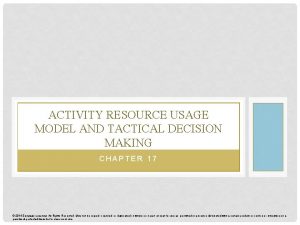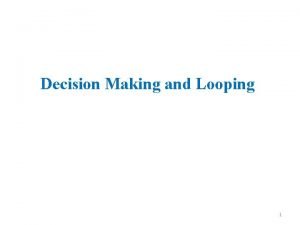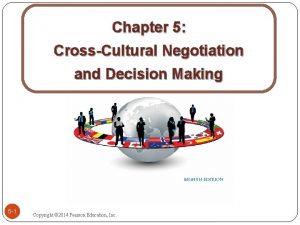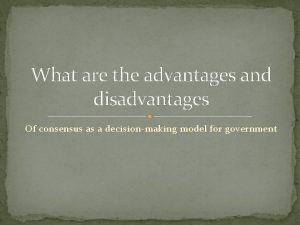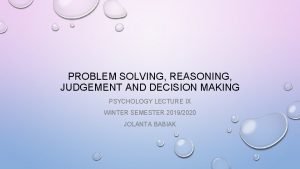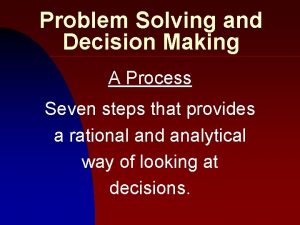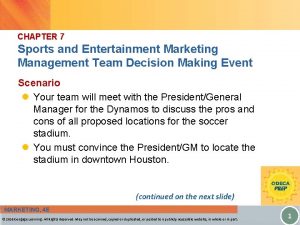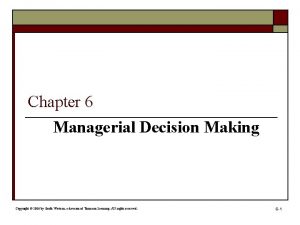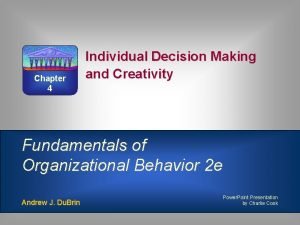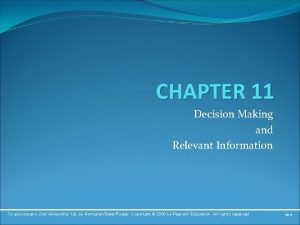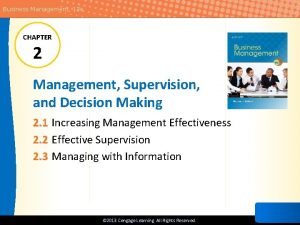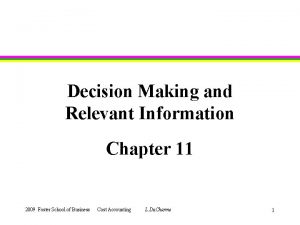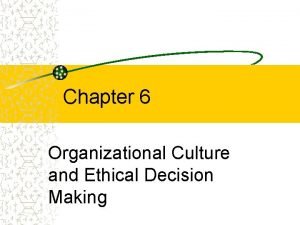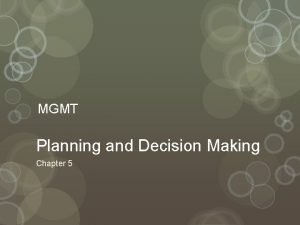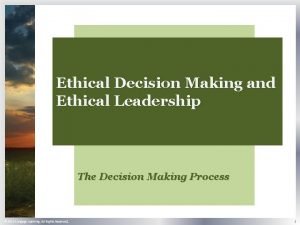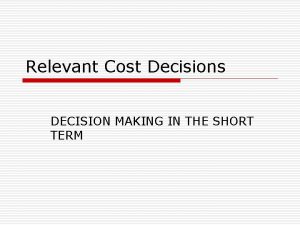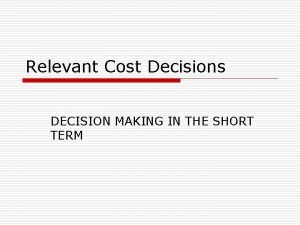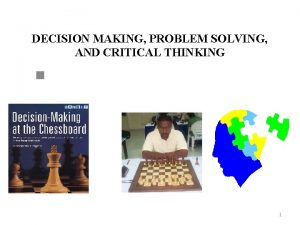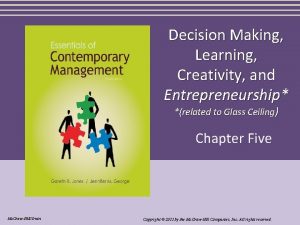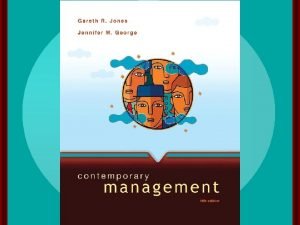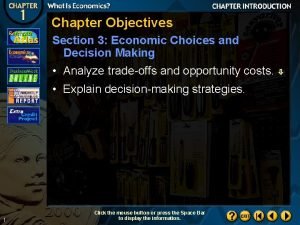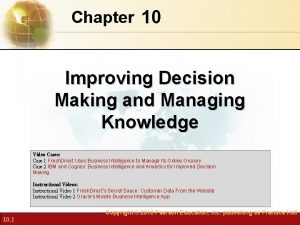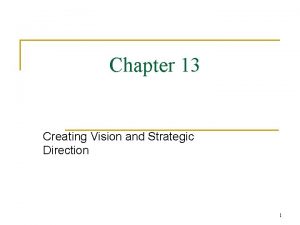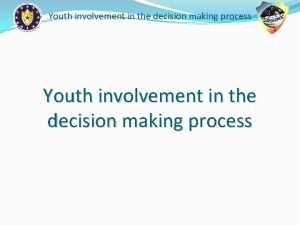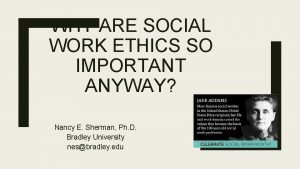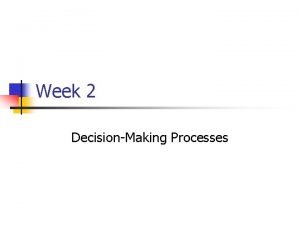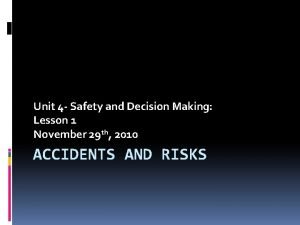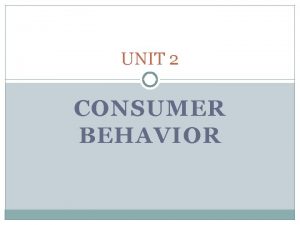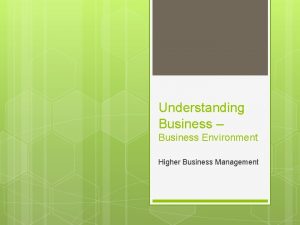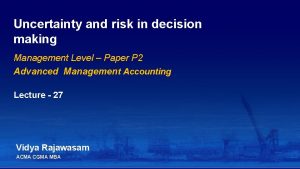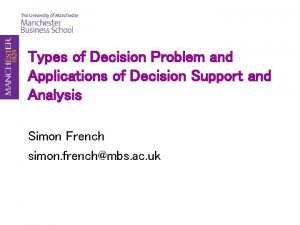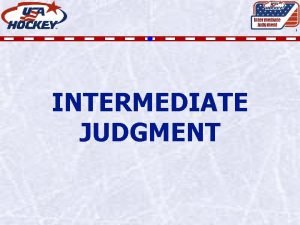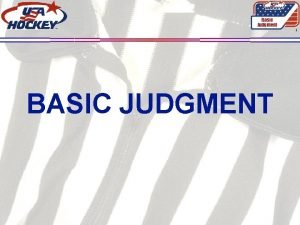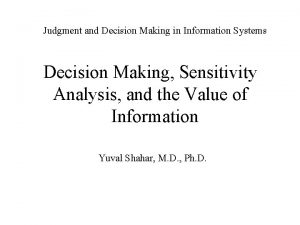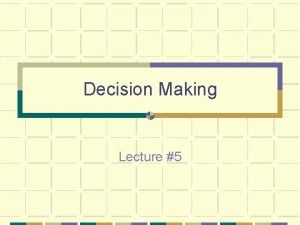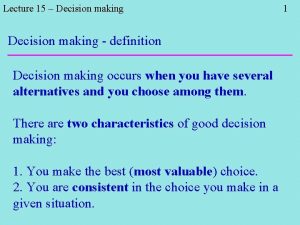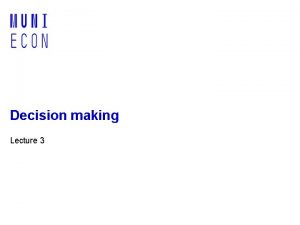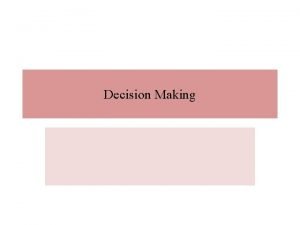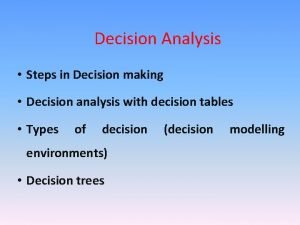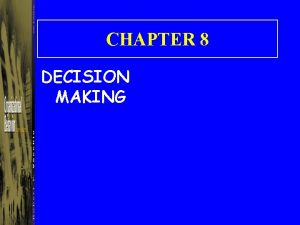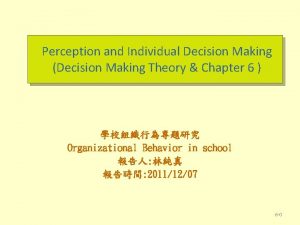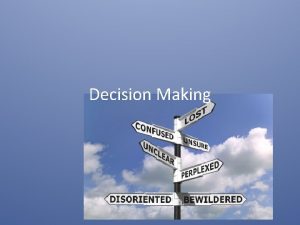Judgment Decision Making Lecture focuses on judgment and



































































- Slides: 67

Judgment & Decision Making • Lecture focuses on judgment and decision making • Seminal work by Kahneman & Tversky (K&T); see Kahneman (2011) Thinking Fast & Slow for more detail • Lecture will review tasks in which people try to behave rationally

Judgment & Decision Making • Kahneman & Tversky showed that people make systematic errors on certain tasks • That is people behave irrationally • Errors can be explained in terms of the psychological processes mediating these tasks

Judgment & Decision Making • Try this example. – Here is a personality sketch written by a psychologist based on tests of uncertain validity – Steve is very shy and withdrawn, invariably helpful but with little interest in people or in the world of reality. A meek and tidy soul, he has a need for order and structure, and a passion for detail. • Is Steve more likely to be a librarian or a farmer? Assume that Steve was selected at random

Judgment & Decision Making • Is Steve more likely to be a librarian or a farmer? Assume that Steve was selected a random • What is your answer? • Why?

Judgment & Decision Making • What is your answer? – Most people choose librarian as the correct answer – Why äSteve resembles the stereotypical librarian äBut this ignores relevant statistical information äMany more farmers than librarians Kahneman and Tversky (KT) proposed that participants made judgment on basis of a heuristic, representativeness

Judgment & Decision Making Here is another example – You see a person reading the New York Review of Books on the TTC subway – Which is the better bet – She has a Ph. D – She does not have a college degree

Judgment & Decision Making • Heuristic – Rule of thumb is a heuristic – Resemblance or representativeness heuristic is not unreasonable, but it leads to predictable errors by participants – E. g. , it ignores base rate information, that is, the fact that many more people are farmers than librarians – Base rate = relative frequency of different members of a group

Judgment & Decision Making • Heuristic – K&T argued that participants typically ignore base -rate information and make judgements on the basis of representativeness

Judgment & Decision Making Kahneman model of judgment and decision making – Two modes or systems of thinking – System 1 – operates automatically and quickly with little or no effort and no sense of voluntary control – System 2 – allocates attention to effortful mental activities – Other terms for these two systems are for system 1, automatic, and for system 2, controlled processing

Judgment & Decision Making – Model of decision making – Characteristics of system 1 (see Kahneman, 2011, page 105 for further details) äGenerates impressions, feelings äOperates automatically and quickly with little effort äCreates a coherent pattern of activated ideas derived from our stored memories äInfers and invents causes and intentions äFocuses on existing evidence and ignores absent evidence

Judgment & Decision Making • Model of decision making – Characteristics of system 2 (see Kahneman, 2011) – Its operations are effortful and require attention – It is lazy, and does not invest more effort than strictly necessary – As a result the decisions that system 2 thinks it has chosen are often guided by system 1

Judgment & Decision Making • Accounting for error in Steve problem – System 1 generates ideas that produce a pattern of a ‘nerdy guy’ – Fits with stereotype of a librarian – System 2 – Endorses this idea and generates response – Note: system 2 did not critically evaluate the info not there, or critically evaluate its validity

Judgment & Decision Making • Anchoring effect heuristic – Here is an example of the anchoring effect – Anchor 1. Is the height of the tallest redwood more or less than 1, 200 feet? – Anchor 2. Is the height of the tallest redwood more or less than 180 feet? äAnchor 1 mean estimate 844 feet äAnchor 2 mean estimate 282 feet

Judgment & Decision Making • Anchoring effect heuristic – Here is an example of the anchoring effect äAnchor 1. Is the height of the tallest redwood more or less than 1, 200 feet? äAnchor 2. Is the height of the tallest redwood more or less than 180 feet? – Results äAnchor 1 mean estimate 844 feet äAnchor 2 mean estimate 282 feet

Judgment & Decision Making • Anchoring effect – Why is anchoring effect observed – Possibility 1 äParticipants believe the tree estimate provides useful information äNext study examined this possibility

Judgment & Decision Making • Anchoring effect – Wheel of fortune study – Wheel of fortune had numbers from 1 -100, but was rigged; stopped only at 10 or 65 – After seeing wheel of fortune stop (at 10 or 65), participants answered the following question – What is your best guess of the percentage of African nations in the UN?

Judgment & Decision Making • Anchoring effect – Wheel of fortune study – Results – When wheel of fortune stopped 10 ; participants guessed 25% – When wheel of fortune stopped 65 ; participants guessed 45% – Conclusion: participants are influenced by uninformative number; suggests system 1 may be operating

Judgment & Decision Making • Anchoring effect – Anchor and adjustment – In some situations people appear to anchor then adjust – E. g. , at what temperature does water boil at peak of Mount Everest äI know water boils at 100 degrees äI know water boils at lower temperatures at higher altitudes so I adjust my estimate downward

Judgment & Decision Making • Anchoring effect – Anchor and adjustment – Anchoring and adjustment appears to require System 2 because adjustment requires attention – Evidence in support of this hypothesis 1. Participants adjust less when mental resources are depleted (memory loaded with digits) and when 2. Participants are slightly drunk

Judgment & Decision Making • Anchoring effect – Anchoring may result from priming (System 1) – Evidence – Participants were asked about average price of German cars with either a high anchor or low anchor price – A high anchor primed luxury brands (Mercedes, audi), low anchor primed mass-market cars (Volkswagen)

Judgment & Decision Making • Anchoring effect – Anchor as priming – Argument – Primed concepts then act to bias estimated price of the average German car

Judgment & Decision Making • Anchoring effect • Conclusions. It appears that under certain circumstances anchoring results from – Priming via System 1 – Adjustment via System 2

Judgment & Decision Making Availability heuristic – Question. äWhat do people do when they wish to estimate the frequency of a category äE. g. , what is the probability that people who enroll in York graduate from York U. ? äWhat is the probability that you will be robbed in the next year?

Judgment & Decision Making Availability heuristic – People assess frequency by judging how easily it is to bring to mind instances äSeveral factors can bias these estimates ä 1. ease of retrievability ä 2. salience of examples (e. g. , observing a violent crime) may increase subjective probability estimates of crime frequency ä 3. media report crimes

Judgment & Decision Making Linda experiment Linda is 31 years old, single, outspoken, and very bright. As a student, she was deeply concerned with issues of discrimination and social justice, and also participated in antinuclear demonstrations. Which alternative is more probable? 1. Linda is a bank teller 2. Linda is a bank teller and is active in the feminist movement?

Judgment & Decision Making Linda experiment Which alternative is more probable? 1. Linda is a bank teller 2. Linda is a bank teller and is active in the feminist movement? How many select option 1. 2.

Judgment & Decision Making Linda experiment Which alternative is more probable? Results from several studies 1. Linda is a bank teller – 15% 2. Linda is a bank teller and is active in the feminist movement? – 85%

Judgment & Decision Making Linda experiment Kahneman and Tversky labelled this the conjunction fallacy. Logically, everyone should choose option 1 because option 1 includes everyone in option 2

Judgment & Decision Making Linda experiment Why do people make this error? Hypothesized that Linda is representative of a stereotyped idea of a feminist (generated by System 1), and system 2 ignored logical fallacy being committed

Judgment & Decision Making Prospect theory Theory developed by Kahneman & Tversky Attempts to understand decision making under conditions of risk This problem has been investigated by several disciplines – statistics, economics, sociology, political science

Judgment & Decision Making History Bernoulli 1738 attempted to explain why people are averse to risk and why risk aversion decreases with increasing wealth Bernoulli proposed that the psychological response to a change in wealth depends upon one’s initial wealth and decreases with increasing wealth. Psychological response to a change in wealth is called utility by economists

Diminishing utility of wealth, Bernoulli

Judgment & Decision Making Bernoulli as figure shows person with more wealth is less risk averse because loss of money results in less utility loss than person with less wealth

Judgment & Decision Making Bernoulli Are people risk averse Try this problem Which would you rather have $80 for sure or 80% chance to win $100 and 20% chance to win $10. Most people choose the sure bet; i. e. , they are risk averse

Judgment & Decision Making Prospect theory Most people choose sure alternative Bernoulli proposed this is because the psychological value of money decreases as the amount of money increases

Judgment & Decision Making Bernoulli Prior to Bernoulli Mathematicians at the time had proposed that the choice selected should be the alternative with the higher expected value; i. e. , gambles were assessed by the weighted average of their outcomes, where each outcome was weighted by their probability

Judgment & Decision Making Expected value of gambling alternatives are: e. g. , expected value of: 80% chance to win $100 and 20% chance to win $10 is $82 (. 8 x 100 +. 2 x 10) Expected value of $80 for sure is $80 (1. 0 x 80) Therefore choose the riskier choice

Judgment & Decision Making Bernoulli Let’s look at Bernoulli again The Table below shows the relation between wealth (in millions) and utility according to Bernoulli wealth 1 utility 2 10 30 3 4 5 6 7 8 9 10 48 60 70 78 84 90 96 100 Note: adding 1 million in wealth to a wealth of 1 million adds utility of 20, but adding 1 million of wealth to 9 million adds a utility of 4

Judgment & Decision Making Prospect theory Bernoulli According to Bernoulli you choose the option with the higher utility. Utility = weighted average of the utilities of the outcomes multiplied by the probabilities (note: utilities are derived from table)

Judgment & Decision Making Bernoulli Example: What would you rather have Equal chances to have 1 million or 8 million Or 4 million with certainty Utility =. 5 probability x 10 (utility) +. 5 probability x 90 utility Utility = 5 + 45 = 50 Or utility of 4 million = 60

Judgment & Decision Making Prospect theory Bernoulli According to Bernoulli you choose the option with the higher utility. Utility = weighted average of the utilities of the outcomes multiplied by the probabilities (note: utilities are derived from table) So you choose the certain option. That is, you are risk averse because of the diminishing subjective value of money (utility)

Judgment & Decision Making Prospect theory importance of Bernoulli’s theory is one of the foundations of economics It explains risk aversion in people Bernoulli’s theory is normative (describes how you should behave) Kahneman & Tversky argued that Bernoulli is wrong in several important respects and proposed prospect theory as a theory of human behavior

Judgment & Decision Making Key assumptions of prospect theory 1. Evaluation of choice is relative to a neutral reference point. Outcomes that are better than the reference point are gains. Outcomes that are worse than reference point are losses. Note, unlike Bernoulli, prospect theory focuses on changes in wealth, not wealth 2. Diminishing sensitivity in the evaluation of wealth (just like Bernoulli)

Judgment & Decision Making Prospect theory Key assumptions of prospect theory 3. Loss aversion. When directly compared to each other, people hate losses more than they like gains

Subjective value of losses and gains, Prospect theory

Judgment & Decision Making Prospect theory this figure has psychological value of money on the y-axis and the dollar amount on the x-axis note that there is a neutral reference point. To the right of the neutral point are gains; to the left are losses note that the S-shaped curve reflects the diminishing sensitivity for gains and losses note that the responses to losses of the Sshaped curve is stronger than the responses to gains. This is loss aversion

Judgment & Decision Making Prospect theory Try this problem Assume you are richer by $300 than you are today. You are offered a choice between A. A sure gain of $100 or B. A 50% chance to gain $200 and a 50% chance to lose $0

Judgment & Decision Making Prospect theory Here are the choices by participants Assume you are richer by $300 than you are today. You are offered a choice between A. A sure gain of $100 or [72%] B. A 50% chance to gain $200 and a 50% chance to lose $0 [28%] Note: most people are risk averse with gains

Judgment & Decision Making Prospect theory Note: most people are risk averse with gains as shown in the previous figure. According to prospect theory, the subjective value of a gain of $100 is more than the 50% of the value of a gain of a second $100

Judgment & Decision Making Prospect theory Try this problem Assume you are richer by $500 than you are today. You are offered a choice between A. A sure loss of $100 or B. A 50% chance to lose $200 and a 50% chance to lose $0 Do you choose option A or option B

Judgment & Decision Making Prospect theory Here are the results from an experiment Assume you are richer by $500 than you are today. You are offered a choice between A. A sure loss of $100 or [36%] B. A 50% chance to lose $200 and a 50% chance to lose $0 [64%] Note: most people are risk seeking with losses; that is, they choose the riskier option

Judgment & Decision Making Prospect theory Note: most people are risk seeking with losses. To see why refer back to the figure. In the cases of losses the pain of losing the second hundred dollars is less than the pain of losing the first hundred, so people are ready to take the risk of losing more to have the chance to get back to no loss.

Judgment & Decision Making Prospect theory In general people are loss averse. That is, a loss hurts more than an equivalent gain. For many people the loss hurts about twice as much as a gain so most people want to avoid a loss. Important implication of prospect theory. It is crucial in making a choice whether you are framing choice in terms of gains or losses if it is a gain you are risk averse if it is a loss you are risk seeking

Judgment & Decision Making Prospect theory – importance of framing Problem 1. Imagine that the U. S. is preparing for the outbreak of an unusual disease, which is expected to kill 600 people. Assume that the exact scientific estimates of the programs are as follows: If Program A is adopted, 200 people will be saved If Program B is adopted, there is a 1/3 probability that 600 people will be saved and a 2/3 probability that no people will be saved

Judgment & Decision Making – Do you prefer program A or program B

Judgment & Decision Making Prospect theory Here are the results If Program A is adopted, 200 people will be saved [72%] If Program B is adopted, there is a 1/3 probability that 600 people will be saved and a 2/3 probability that no people will be saved [28%] Note: most people choose the risk averse option.

Judgment & Decision Making Prospect theory – importance of framing Note: most people choose the risk averse option. Why. The problem is ‘framed’ as follows: reference point is that 600 people will die and 2 possible options described as gains are presented. Since it is framed as a gain, prospect theory predicts that people will be risk averse

Judgment & Decision Making Prospect theory Problem 2. Same cover story but with the following options If Program C is adopted, 400 people will die If Program D is adopted, there is a 1/3 probability that nobody will die and a 2/3 probability that 600 people will die. Which program do you select C or D?

Judgment & Decision Making Prospect theory Problem 2. Same cover story but with the following options If Program C is adopted, 400 people will die (22%) If Program D is adopted, there is a 1/3 probability that nobody will die and a 2/3 probability that 600 people will die. (78%) Note: people are risk seeking here

Judgment & Decision Making Prospect theory Note: options A and B and C and D are logically indistinguishable. However, for C and D the alternative are in terms of losses – people dying – not gains as for options A and B

Judgment & Decision Making Prospect theory Because alternatives are framed as losses, prospect theory predicts that participants will select the risk seeking behavior Conclusion. When dealing with gains, people tend to be risk averse. When dealing with losses, people tend to be risk seeking. The wording of options has a strong effect on choices people make Called the framing effect

Judgment & Decision Making Intertemporal choice refers to a situation in which a person must choose between a smaller immediate reward and a larger reward later.

Judgment & Decision Making Intertemporal choice Marshmellow experiment classic intertemporal experiment Walter Mischel carried out a series of experiments with 4 and 5 year old children. Each child was shown into a private room and seated at a table. In front of the child was marshmellow. Child was told that experimenter was leaving for a while and if the marshmellow was not eaten the child would get a second marshmellow.

Judgment & Decision Making Intertemporal choice Marshmellow experiment classic intertemporal experiment Results. Many children could not control themselves and ate the marshmellow. Interpretation. According to the discounting perspective, the subjective value of the reward is discounted from its nominal amount as the delay increases

Judgment & Decision Making Intertemporal choice Procedure for studying temporal discounting. Participants choose between a smaller immediate reward and a larger delayed reward. Participants makes a series of choices in which the amount of the immediate reward is varied at a given delay. Using this procedure you can determine the subjective value of the delayed reward at a given delay. (Green & Myerson, 2004)

Temporal discounting procedure (from Green & Myerson, 2004) People make a series of choices between a smaller amount now and a larger amount in 6 months Goal to determine the immediate dollar value that receiving $1000 is equal to. By doing this for a series of different time delays (e. g. , 1 week, 1 month, 6 mos, 1 year, 10 years it is possible to obtain a discounting curve

Subjective value of $1000 at different delays (Green & Myerson, 2004) Notes 1. The subjective value of $1000 at a short delay is almost $1000 but drops to less than $400 after 6 months. 2. All participants show temporal discounting. Older adults show less steep temporal discounting
 Judgment in managerial decision making 8th edition
Judgment in managerial decision making 8th edition Mythical fixed pie assumption
Mythical fixed pie assumption No decision snap decision responsible decision
No decision snap decision responsible decision Investment decision financing decision dividend decision
Investment decision financing decision dividend decision 01:640:244 lecture notes - lecture 15: plat, idah, farad
01:640:244 lecture notes - lecture 15: plat, idah, farad Decision theory lecture notes
Decision theory lecture notes Sargur srihari
Sargur srihari Decision table and decision tree examples
Decision table and decision tree examples Mamdm
Mamdm Using functions in models and decision making
Using functions in models and decision making Chapter 6 prices and decision making assessment answers
Chapter 6 prices and decision making assessment answers Model hoy
Model hoy Decision making and relevant information
Decision making and relevant information Best books on problem solving and decision making
Best books on problem solving and decision making Individual and group decision making
Individual and group decision making Individual and group decision making
Individual and group decision making Perception and individual decision making
Perception and individual decision making 5 step decision making process
5 step decision making process A is a choice made from among available alternatives
A is a choice made from among available alternatives Chapter 2 economic systems and decision making answer key
Chapter 2 economic systems and decision making answer key Decision making and branching in c
Decision making and branching in c Elements of planning
Elements of planning Individual and group decision making
Individual and group decision making Management chapter 5 planning and decision making
Management chapter 5 planning and decision making What they see
What they see Decision making and goal setting
Decision making and goal setting Chapter 2 economic systems and decision making
Chapter 2 economic systems and decision making Individual and group decision making
Individual and group decision making Activity resource usage model and tactical decision making
Activity resource usage model and tactical decision making Activity resource usage model and tactical decision making
Activity resource usage model and tactical decision making Decision making process definition
Decision making process definition Sentinel controlled loop flowchart
Sentinel controlled loop flowchart Cross cultural negotiation and decision making
Cross cultural negotiation and decision making Relevant information for decision making
Relevant information for decision making What are the disadvantages of consensus making
What are the disadvantages of consensus making Judgement and decision making reasoning
Judgement and decision making reasoning 7 steps of problem solving and decision making
7 steps of problem solving and decision making Chapter 2 economic systems and decision making
Chapter 2 economic systems and decision making Example of non programmed decision
Example of non programmed decision Sports and entertainment marketing performance indicators
Sports and entertainment marketing performance indicators 6 step decision making process
6 step decision making process Decision making and creativity organizational behavior
Decision making and creativity organizational behavior Chapter 11 decision making and relevant information
Chapter 11 decision making and relevant information Chapter 2 management supervision and decision making
Chapter 2 management supervision and decision making Decision making and relevant information
Decision making and relevant information Organizational culture and ethical decision making
Organizational culture and ethical decision making Options-based planning
Options-based planning The perceived relevance or importance of an ethical issue
The perceived relevance or importance of an ethical issue Steps in decision making
Steps in decision making Decision making and relevant information
Decision making and relevant information Critical thinking problem solving and decision making
Critical thinking problem solving and decision making The pattern of faulty and biased decision making
The pattern of faulty and biased decision making The pattern of faulty and biased decision making
The pattern of faulty and biased decision making Chapter 1 section 3 economic choices and decision making
Chapter 1 section 3 economic choices and decision making Improving decision making and managing knowledge
Improving decision making and managing knowledge Creating vision and strategic direction
Creating vision and strategic direction War making and state making as organized crime summary
War making and state making as organized crime summary Youth involvement
Youth involvement Nasw code of ethics
Nasw code of ethics Systematic decision making process
Systematic decision making process What doing our country
What doing our country Defining moments
Defining moments Unit 4 lesson 1 decision making
Unit 4 lesson 1 decision making Decision making to improve marketing performance
Decision making to improve marketing performance Types of decision making
Types of decision making Pestec higher business
Pestec higher business Contribution payoff table
Contribution payoff table Types of decision making
Types of decision making
